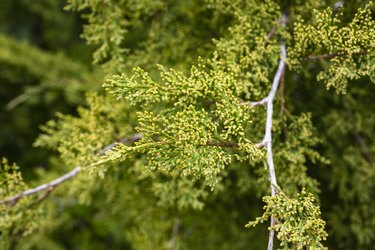
Things You'll Need
Ladder
Garden shears
Pruning saw
Bleach or a household disinfectant
The Eastern red cedar tree (Juniperus virginiana) is actually a variety of juniper well known for the enticing odor of the wood and ornamental evergreen leaves. Cedar trees tend to grow in a disorganized pyramid shape so cedar tree pruning can help improve the appearance of the tree.
Trimming growth in an efficient but generally minimal way will allow for a more balanced, healthy tree. Low hanging branches often interfere with roadways and pedestrian walkways. Their potential height of up to 50 feet may also cause problems in smaller garden spaces. Trimming is not necessary to grow a strong tree.
Video of the Day
Step 1: Prepare for Cedar Tree Pruning
Disinfect your pruning tools. Soak them in a 10 percent bleach solution or wipe the blades with a household disinfectant such as Lysol.
Step 2: Remove Branches Competing With Trunk
Trim large branches competing with the main trunk in young trees. There should be only one main trunk that points straight up. In young trees less than two years old, several branches often compete for this job. You may have to trim these weaker competing trunks a year after the initial cut back. Trimming should be done in late winter or early spring to avoid removing the buds that will form new growth.
Step 3: Remove Branches Touching the Ground
Remove all branches that hang low to the ground, touch the ground directly, or grow straight down from the trunk or branch. These can form new trees if they touch the soil and are left for several weeks.
Step 4: Prune to Shape the Tree
Follow the natural shape of the tree. Eastern red cedars tend to grow in an uneven, sloppy pyramid shape. When trimming the bottom branches of a cedar tree, leave the lowest branches the longest, and gradually shorten the length of branches as you move towards the top of the tree. Do not remove more than 6 to 12 inches of green growth, as the external layer of leaves are the greenest and your tree may look bare for a long time. Once leaves turn brown in the interior of the tree, they do not grow back the vibrant green of external leaves.
Step 5: Shorten the Cedar Tree
Can you trim the top of cedar trees? Top off the tree if it is outgrowing your garden, but do not remove more than 1/4 of the tree's full height.
Step 6: Prune Large Branches
Evaluate the heft and presence of large branches before trimming them back. Mature trees can withstand entire branches being trimmed back to the trunk. Trimming seldom kills a red cedar tree, but it can greatly affect its appearance for years. A large gap left from removing a significant branch could take years to fill.
Tip
Do not trim an Eastern red cedar after July 15. This will remove the buds that will form the following year's spring growth. Removing these buds forces the red cedar tree to grow new ones. This diverts resources from keeping the tree alive through winter to creating new buds, which can weaken the tree and make it more vulnerable to a variety of pests, infections and frost damage.
Video of the Day